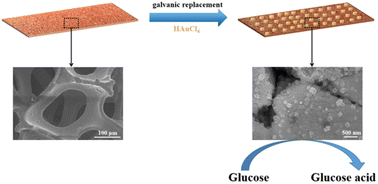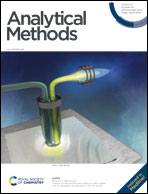Surface charge modulation enhanced high stability of gold oxidation intermediates for electrochemical glucose sensors†
Abstract
Rapid and accurate blood glucose detection is significant for diagnosing and treating diabetes. Herein, ultra-low-content gold nanoparticles were loaded on different metal foams and applied to electrochemical enzyme-free glucose sensors via simple displacement reactions. The structures and properties of the produced catalysts were determined by various characterization methods. The performance of the glucose sensor was examined in relation to the interactions between three different metal substrates and gold. The one with the best performance is the sample of gold nanoparticles grown on copper foam (Au300 Cu Foam). It has the advantage of a porous three-dimensional network, a large electroactive surface area, and the high catalytic activity of gold. The combination of Cu and Au increased the valence state of Au, thus favoring the catalytic activity for glucose oxidation. Cyclic voltammetry and chronoamperometry measurements revealed that Au is responsible for the electrocatalytic oxidation of glucose. The sensitivity of Au300 Cu Foam was found to be 10 839 μA mM−1 cm−2 in the linear range of 0.00596–0.0566 mM, with a detection limit (LOD) of 0.223 μM, and 2–3 s response time at 0.4 V vs. Ag/AgCl. The Au300 Cu Foam glucose sensor also offered outstanding stability and anti-interference performance. The prepared Au300 Cu Foam electrode was also successfully applied to detect different levels of glucose in human body fluids, such as saliva. These characteristics make Au300 Cu Foam promising for non-invasive glucose detection.

- This article is part of the themed collection: Analytical Methods HOT Articles 2022


 Please wait while we load your content...
Please wait while we load your content...